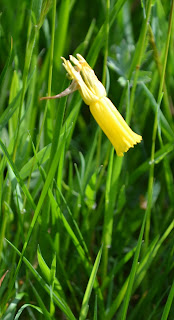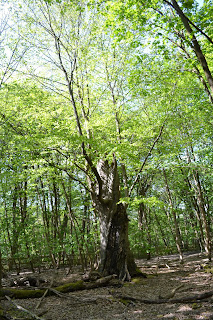Length: half day.
We visited two
sites - Savill Gardens
The car park at Savill Gardens Savill Building
Meadow saxifrage amongst
small Sedum leaves
After entry we
descended the grass slope towards the lake.
On this slope a group of daffodils with 1-3 flowers per stem, of medium
size, appeared to be the cultivar 'Sweetness' (see picture).
'Sweetness' daffodil
Pale purple form of wood
anemone
Narcissus
bulbocodium
Bogbean in the lake
In The Glades the N. bulbocodium was accompanied by
bluebell Hyacinthoides non-scripta,
cowslip Primula veris, and
fritillaries Fritillaria meleagris, a
good many the white form that hints that these, like the daffodils, were
introduced, as the white form constitutes only a very small percentage of
"native" or at least long-established populations. Other introductions in this meadow are Erythronium revolutum, a lily with
marbled leaves, and Asian skunk-cabbage Lysichiton
camtschatcensis in the brook. St
Georges Mushroom Calocybe gambosa
also grew here.
Narcissus
bulbocodium
in The Glades with a couple of Narcissus
minor
Fritillaries by the brook
in The Glades
Erythonium
revolutum
Asian skunk-cabbage
The other species
daffodil long-naturalised in the Gardens is the cyclamen daffodil Narcissus cyclamineus, so named for its
swept-back petals. There is a large plot
of this beyond the Glades as you approach the Spring Garden
Narcissus
cyclameneus
We completed the
tour of the garden past the Queen Elizabeth Temperate House and back to the
river and its lakes. Striking plants
included the following.
Rhododendrons augustinii cv 'Electra' (upper)
& 'Baden Baden' hybrid
'Essex Scarlet' x forrestii 'Repens'
(lower)
Lily of the valley
Acer
palmatum 'Dissectum'
'Salome' daffodil with
pink trumpet
'Coleman Hybrid' daffodil
'Baby Moon' daffodil
'Toto' daffodil
Inside the warm
Temperate House mossy clubmoss Selaginella
kraussiana was spreading like a weed, although we did not see it escaped,
as it does occasionally in the south-west.
Mossy Clubmoss inside the
Temperate House
By the stream
American skunk-cabbage Lysichiton
americanus is well naturalised, and we saw one small patch of blinks Montia fontana
American skunk-cabbage
As we returned to
the entrance we noticed a fenced grass plot where another species daffodil was
being naturalised, this time the multi-flowered creamy Narcissus triandrus from the Iberian peninsula .
Narcissus
triandrus
We then drove to
the car-park on the A332 at SU948727, opposite a pink lodge called Cranbourne
Gate. This provides access to a small
part of the old woodland of Cranbourne Chase.
Immediately by the entrance to the car-park is one venerable pollard oak
Quercus robur, over 700 metres girth,
which is split but apparently in good condition.
There are similar
pollard oaks all along this part of the A332, easily seen from a car.
Old pollard oak by A332
Also near the entrance was shining
cranesbill Geranium lucidum, but the
ground flora in this area is generally poor with thin acid soils and improved
grassland.
Shining cranesbill
To the south more
old oaks in various states of disrepair were visible in cow pasture.
In the semi-open
woodland west of the car-park roamed cattle that looked very like the
Chillingham breed, closest to the original wild cattle. We also saw roe deer.
Chillingham? bull,
Cranbourne Chase
We followed a
sandy riding track (there seem to be no footpaths) through the woodland, past a
fine display of bluebells.
Cranbourne Chase
Most of the
veteran trees here are oak, but we did see the odd beech Fagus sylvatica, hosting the common willow bracket Phellinus igniarius.
Old beech, Cranbourne
Chase
Another old oak,
Cranbourne Chase
While the veterans
are oak and beech, the younger growth trees are mainly sycamore Acer pseudoplatanus with hawthorn Crataegus monogyna scrub, while ash
seedlings Fraxinus excelsior dominate
the ground layer, showing a very different wood developing. There were also some tall old apple trees,
but Malus domestica, not the true
crab apple.
Apple blossom
The riding track
bent back round to the road opposite Rangers Gate. We crossed the A332 here and found by the
gate some clumps of early scurvy-grass Cochlearia
danica, a sign of road-salting. By
the lodge was another impressive old oak.
Early scurvy-grass, Rangers
Gate
Old oak by Lodge, Rangers
Gate
We entered the
main part of Windsor
Great Park
Vista towards Windsor Castle
We took the path
to Queen Anne's Ride and up there to The Village, where grotesque lime-trees Tilia x europaea, much lopped and pruned
against their natural growth, were festooned with large clumps of mistletoe Viscum album. They stand near the Millstone statue
commemorating the planting of 1000 trees along this ride in 1992, replacing
veterans that were taken down because they looked decrepit, not recognising
they were invaluable for invertebrates and fungi in that state, and even have a
certain Gothic scenic value.
Mistletoe limes by The
Village and the Millstone
We went east from
this spot towards the 1829 copper statue of George III on Snow Hill. We passed an excellent large veteran oak
which was not far under 10 metres in girth.
The emergence holes in some of the dead wood showed that it was being
well used by beetles.
Ancient oak with girth of
nearly 10 metres
Bark of the veteran oak
This route also
passed some old hornbeams Carpinus
betulus and some fragments of wood stained blue by the Green Elfcup
fungus. There was another long vista to Windsor Castle

















































